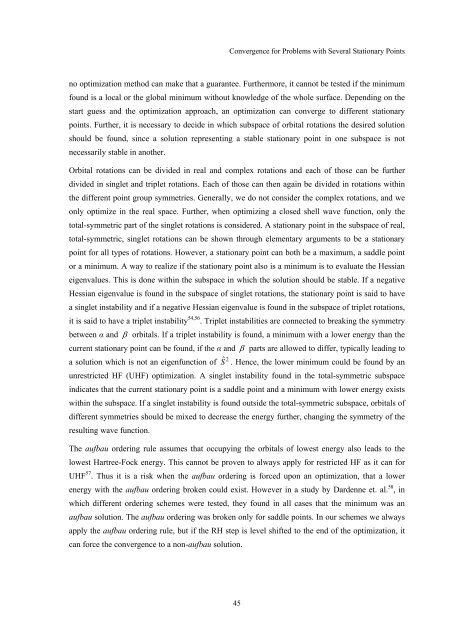Get my PhD Thesis
Get my PhD Thesis
Get my PhD Thesis
You also want an ePaper? Increase the reach of your titles
YUMPU automatically turns print PDFs into web optimized ePapers that Google loves.
Convergence for Problems with Several Stationary Points<br />
no optimization method can make that a guarantee. Furthermore, it cannot be tested if the minimum<br />
found is a local or the global minimum without knowledge of the whole surface. Depending on the<br />
start guess and the optimization approach, an optimization can converge to different stationary<br />
points. Further, it is necessary to decide in which subspace of orbital rotations the desired solution<br />
should be found, since a solution representing a stable stationary point in one subspace is not<br />
necessarily stable in another.<br />
Orbital rotations can be divided in real and complex rotations and each of those can be further<br />
divided in singlet and triplet rotations. Each of those can then again be divided in rotations within<br />
the different point group symmetries. Generally, we do not consider the complex rotations, and we<br />
only optimize in the real space. Further, when optimizing a closed shell wave function, only the<br />
total-symmetric part of the singlet rotations is considered. A stationary point in the subspace of real,<br />
total-symmetric, singlet rotations can be shown through elementary arguments to be a stationary<br />
point for all types of rotations. However, a stationary point can both be a maximum, a saddle point<br />
or a minimum. A way to realize if the stationary point also is a minimum is to evaluate the Hessian<br />
eigenvalues. This is done within the subspace in which the solution should be stable. If a negative<br />
Hessian eigenvalue is found in the subspace of singlet rotations, the stationary point is said to have<br />
a singlet instability and if a negative Hessian eigenvalue is found in the subspace of triplet rotations,<br />
it is said to have a triplet instability 54,56 . Triplet instabilities are connected to breaking the symmetry<br />
between α and β orbitals. If a triplet instability is found, a minimum with a lower energy than the<br />
current stationary point can be found, if the α and β parts are allowed to differ, typically leading to<br />
2<br />
a solution which is not an eigenfunction of Ŝ . Hence, the lower minimum could be found by an<br />
unrestricted HF (UHF) optimization. A singlet instability found in the total-symmetric subspace<br />
indicates that the current stationary point is a saddle point and a minimum with lower energy exists<br />
within the subspace. If a singlet instability is found outside the total-symmetric subspace, orbitals of<br />
different symmetries should be mixed to decrease the energy further, changing the symmetry of the<br />
resulting wave function.<br />
The aufbau ordering rule assumes that occupying the orbitals of lowest energy also leads to the<br />
lowest Hartree-Fock energy. This cannot be proven to always apply for restricted HF as it can for<br />
UHF 57 . Thus it is a risk when the aufbau ordering is forced upon an optimization, that a lower<br />
energy with the aufbau ordering broken could exist. However in a study by Dardenne et. al. 58 , in<br />
which different ordering schemes were tested, they found in all cases that the minimum was an<br />
aufbau solution. The aufbau ordering was broken only for saddle points. In our schemes we always<br />
apply the aufbau ordering rule, but if the RH step is level shifted to the end of the optimization, it<br />
can force the convergence to a non-aufbau solution.<br />
45

















